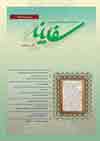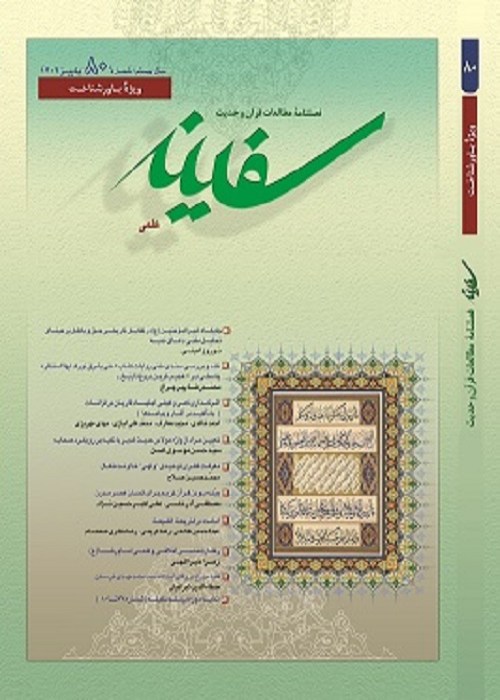فهرست مطالب

نشریه سفینه
پیاپی 67 (تابستان 1399)
- تاریخ انتشار: 1399/07/01
- تعداد عناوین: 9
-
-
صفحه 5
-
صفحه 10
پیوند ناگسستنی نهج البلاغه و قرآن، زمینه ساز گزینش هدفمند مضامین در گزاره های نهج البلاغه است. در پژوهش حاضر با رویکرد بینامتنیت مضمونی، به تبیین تبادل محتوایی دو متن نهج البلاغه و قرآن درباره آیه اهتداء (یونس:35) پرداخته می شود. آیه هدایت، به عنوان یکی از مستندات متکلمان شیعی در جهت اثبات لزوم افضلیت امام مورد استناد قرار گرفته است. نکته قابل تامل در این آیه، تعیین مصداق افضل در هدایت بخشی می باشد. نگارندگان، با تکیه بر روش توصیفی- تحلیلی و ارتباط بینامتنی مضمونی، مجموعه گزاره های نهج البلاغه را که ارتباط محتوایی با آیه اهتداء داشته، رصد نموده اند. نتایج پژوهش حاکی از آن است که استخراج رابطه بینامتنی مضمونی نهج البلاغه و آیه اهتداء در رفع ابهام آیه پیرامون تعیین مصداق «احقیت در هدایت بخشی» بسیار نقش آفرین است. بر اساس یافته ها، همان گونه که در کتاب های معتبر تفسیری و روایی مصداق آیه اهتداء به طور خاص، حضرت امیر المومنین علی (ع) معرفی شده است، در واکاوی تعامل بینامتنی گزاره های نهج البلاغه با آیه هدایت، فرآیند فهم و تفسیر صحیح این آیه تسهیل می شود.
کلیدواژگان: نهج البلاغه، امامت، افضلیت، آیه اهتداء (یونس:35) -
صفحه 35
با پیدایش رویکرد متاخران در اعتبارسنجی، بخش بندی احادیث به صحیح، حسن، موثق و ضعیف رخ نمود. بر پایه این رویکرد، احراز وثاقت راویان در حکم به اعتبار حدیث نقشی بنیادین ایفا می کند؛ این در حالی است که تعداد قابل توجهی از راویان واقع در اسناد روایات، یا اطلاعاتی در بیان شخصیت روایی آنان وجود ندارد و یا تضعیف شده اند. این دو پدیده گروهی از پژوهشگران را بر آن داشته تا برای اثبات وثاقت دست کم تعدادی از راویان این دو گروه، به سراغ مبانی توثیقات عام روند. یکی از پربسامدترین مصادیق توثیقات عام، قاعده اکثار است. بر پایه این قاعده، در نظر رجالیان، فراوانی روایت یک راوی ثقه از استاد ناشناخته یا ضعیف، کاشف از وثاقت استاد در نگاه راوی است. در این نوشتار به بازخوانی این قاعده و ابهاماتی پیرامون آن پرداخته شده است. باور این پژوهش بر آن است که قاعده اکثار بر پایه تقریر مورد مطالعه، توان اثبات وثاقت راویان را ندارد.
کلیدواژگان: توثیقات عام، قاعده اکثار، وثاقت، ضعف، توثیق عملی، توثیق قولی -
صفحه 60
با توجه به تعدادی از آیات قرآن کریم، احتمال صدور کذب از حضرت ابراهیم و حضرت یوسف علیهما السلام در برخی از آرای علما مطرح شده است. علمای فریقین هریک به نوعی درصدد تبیین این آیات برآمده و نظرات مختلفی در توجیه اقدام این دو پیامبر الهی بیان کرده اند که می توان به طور کلی به دو رویکرد صدق گرایانه و کذب گرایانه همراه با توجیه (تقیه، توریه، معاریض کلام یا تعریض، دروغ اضطراری و مصلحت...) خلاصه کرد. با بررسی منابع روایی که در تبیین این آیات، به ویژه در اصول الکافی آمده است، هر دو نگاه به طور مطلق نفی می شود و از دل این روایات و خانواده های حدیثی آن می توان راهکار سومی ارایه کرد که در این مقاله بدان پرداخته شده است، راهکاری که ضمن حل اشکالات وارده در این باره، تبیین بسیار دقیقی از آیات مذکور را در اختیار مخاطب قرار می دهد. مقاله حاضر تلاش دارد به ارایه نمونه ای موردی از کارآمدی منابع روایی در تبیین آیات مشکله، با توجه به خانواده حدیثی -روایات هم مضمون- به خصوص از روایات اصول الکافی کلینی بپردازد؛ که نمونه آن را تنها در مکتب حدیثی اهل بیت علیهم السلام، و البته با تبیین و تحلیل آنها قابل مشاهده است. این احادیث می توانند پاسخگوی شبهات حول داده های معارفی برخی آیات قرآن باشند و از طرفی این دیدگاه مویداتی نیز در منابع فریقین دارد.
کلیدواژگان: آیات مشکله، کذب انبیا، عصمت انبیا، روایات تفسیری، اصول الکافی، اصلاح -
صفحه 89
این مقاله با مروری بر کتاب "شرح محتوایی رساله تبارک" و دو مقاله که در فصلنامه سفینه پیرامون این کتاب نوشته شده، توضیحاتی بر دیدگاه میرزا مهدی اصفهانی در باره حجیت جمعیه قرآن و عترت بیان می دارد. اصل نفی تشبیه میان خدا با مخلوق، و در پی آن عدم مشابهت کلام خدا با کلام بشر، با تبیین های مختلف در این مقاله بحث شده و به نتایجی رسیده است.
کلیدواژگان: شرح محتوایی رساله تبارک (کتاب)، حجیت قرآن، حجیت جمعیه قرآن و عترت، نفی تشبیه میان خدا با مخلوق، عدم مشابهت کلام خدا با کلام بشر، اصفهانی، مهدی -
صفحه 119
تحلیل دیدگاه های شیخ مفید در باره آثار محدثان شیعه به ویژه شیخ صدوق، موضوع اصلی این مقاله است. نگارنده، با توجه به تفاوت شیوه کار و مخاطبان دو گروه از دانشمندان شیعی، پنج نکته برای شیوه محدثان بر می شمارد که آثار متکلمان و فقیهان با محدثان، از این جهات تفاوت داشته است. عمده ترین منابع مقاله، آثار شیخ مفید است.
کلیدواژگان: شیخ مفید، شیخ صدوق، تاریخ تشیع - قرن 4 و 5، محدثان شیعه، متکلمان شیعه، فقیهان شیعه -
صفحه 139
نگارنده برای بررسی جایگاه عترت در تفسیر قرآن، مقاله را با تعریف کلمات عترت و قرآن و تفسیر آغاز کرده و مصداق عالمان به دانش های قرآن را بر اساس آیات و روایات معتبر مشخص می کند که کسی جز عترت پیامبر نیست. برای تایید این نتیجه، به فهم اهل زمان نزول از آیات قرآن و نیز اختلاف مفسران در مورد معنای شفا بودن قرآن استناد می کند.
کلیدواژگان: قرآن، عترت، تبیین قرآن، شب قدر، علم قرآن، تفسیر، شفا بودن قرآن -
صفحه 166
مباحثی مانند جایگاه قرآن و حقوق آن، ضرورت شناخت این حقوق و روش های استخراج آنها از متون دینی، مقدمات بحث نگارنده است. آنگاه سه وظیفه قلبی در برابر قرآن را با استناد به آیات و احادیث، تحلیل و بررسی می کند: ایمان به قرآن، پذیرش مرجعیت علمی قرآن، پذیرش حاکمیت و داوری قرآن.
کلیدواژگان: حقوق قرآن، جایگاه قرآن، ایمان به قرآن، پذیرش مرجعیت علمی قرآن، پذیرش حاکمیت و داوری قرآن -
صفحه 190
-
Page 10
The inseparable link between Nahj al-Balaghah and the Qur'an paves the way for the purposeful selection of themes in the propositions of Nahj al-Balaghah. In the present study, with the thematic intertextuality approach, the content exchange of the two texts of Nahj al-Balaghah and the Qur'an about the verse of guidance (Yunus: 35) is explained. The verse of guidance has been cited as one of the documents of Shiite theologians in order to prove the necessity of the superiority of the Imam. The point to consider in this verse is to determine the best example in guiding. The authors, relying on the descriptive-analytical method and thematic intertextual relationship, have observed the set of propositions of Nahj alBalaghah that have a content relationship with the verse of guidance. The results of the research indicate that the extraction of the thematic intertextual relationship between Nahj al-Balaghah and the verse of Ihtada plays a very important role in removing the ambiguity of the verse regarding determining the instance of "the most rightful in guidance". Based on the findings, as Amir al-Mu'minin Ali (AS) has been specifically introduced in the authentic commentary and narration books as the example of the verse of Ihtada, through the analysis of the intertextual interaction of Nahj al-Balagheh propositions with the verse of guidance, the process of correct understanding and interpretation of this verse is facilitated.
-
Page 35
With the emergence of the approach of late scholars in validation, the division of hadiths into Sahih , Hasan, Muvaththaq (reliable) and Za’if (weak) occurred. Based on this approach, the authenticity of the narrators in the validity of the hadith plays a fundamental role; However, concerning a significant number of narrators mentioned in narration documents no clear information in expressing their narrative personality exist or if any, they are weakened. These two phenomena have led a group of researchers to go to the basics of general authentication to prove the authenticity of at least some of the narrators of these two groups. One of the most common examples of public authenticity is the rule of اکثار (majority). According to this rule, in the opinions of the rijals, the frequency of the narration of a trustworthy narrator from an unknown or weak master reveals the trustworthiness of the master in the eyes of the narrator. This article rereads this rule and the ambiguities surrounding it. This study believes that the rule of majority based on the narration under study, can not prove the credibility of the narrators.
-
Page 60
According to a number of verses of the Holy Quran, the possibility of issuing a lie from Prophet Ibrahim and Prophet Yusuf (as) has been raised in some opinions of scholars. The scholars of the two sects have each tried to explain these verses in a way and have expressed different views in justifying the action of these two divine prophets, which can be generally attributed to two approaches of truth-oriented and falseoriented along with justification (Taqiyya, Toriyah, urgent lies and expediency...). By examining the narrative sources that are mentioned in the explanation of these verses, especially in the Usul Al-Kafi, both views are absolutely negated, and from the hearts of these narrations and its hadith families, a third solution can be presented, which in this article has been dealt with: a solution that, while solving the problems in this regard, provides the audience with a very accurate explanation of the mentioned verses. The present article tries to provide a case concerning the efficiency of narrative sources in explaining the difficult verses, according to the hadith family – the same meaning narrations –especially from the narrations of the Usul Al-Kafi by Kulayni which its example can be seen only in the hadith school of Ahl al-Bayt (as), and they become clear by explaining and analyzing them. These hadiths can answer the doubts about the some verses of the Qur'an, and on the other hand, this view is also supported by the sources of the two sects.
-
Page 89
This article reviews Mirza Mehdi Esfahani's views on the collective authority of the Qur'an and ‘Itrat by reviewing the book "Content Description of Tabarak risalah" and two articles written about it in Safineh Quarterly. The principle of denying the similarity (Tashbih) between God and creature, and the consequent of it which is dissimilarity of God's word with human word, has been discussed in this article with various explanations and has reached some conclusions
-
Page 119
Analysis of Sheikh Mofid's views on the works of Shiite narrators, especially Sheikh Saduq, is the main subject of this article. The author, considering the difference between the method of work and the audience of the two groups of Shiite scholars, enumerates five points for the method of the narrators that the works of theologians and jurists differ from the narrators in these respects. The main sources of the article are the works of Sheikh Mofid.
-
Page 139
To examine the position of ‘Itrat in the interpretation of the Qur'an, the author begins the article by defining the words ‘Itrat , the Qur'an and Tafsir, and identifies the examples of scholars with the knowledges of the Qur'an based on authentic verses and hadiths that no one is other than the Prophet. To confirm this conclusion, he cites the understanding of the people of the time of revelation of the verses of the Qur'an and also the differences of the commentators about the meaning of Qur'an being Shafa (healing).
-
Page 166
Issues such as the status of the Qur'an and its rights, the need to know these rights and the methods of extracting them from religious texts are the preliminaries of the author's discussion. He then analyzes and examines three heart duties towards the Qur'an by quoting verses and hadiths: believing in the Qur'an, accepting the scientific authority of the Qur'an, accepting the rule and judgment of the Qur'an.


